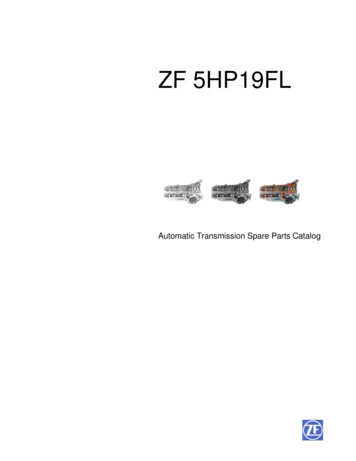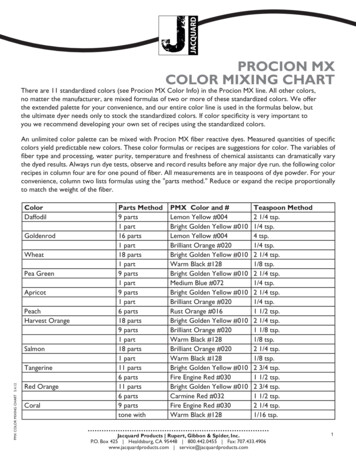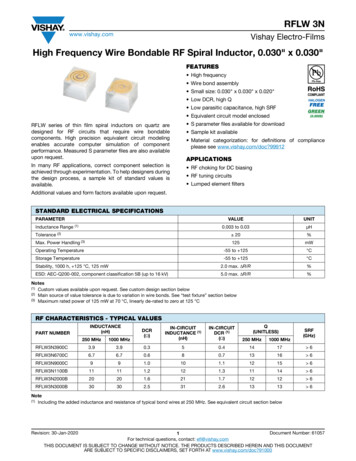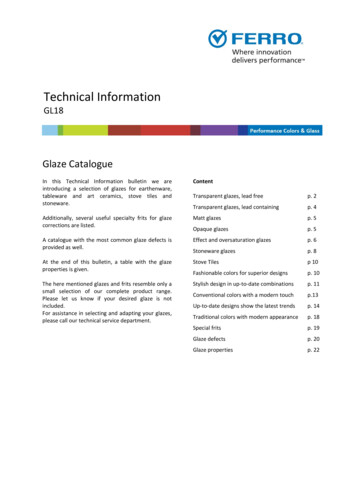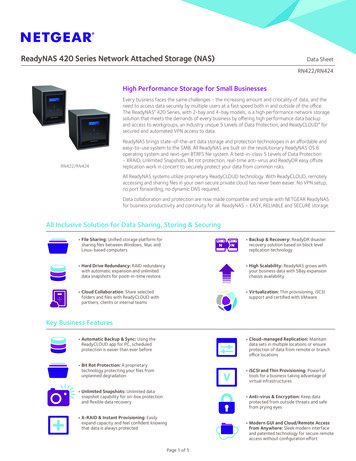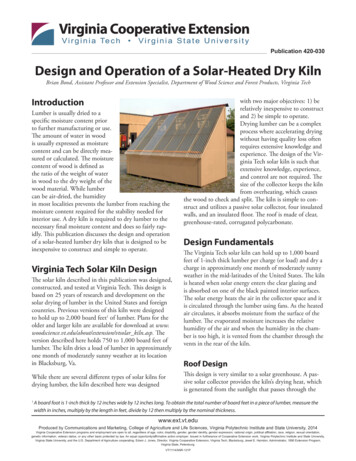
Transcription
Publication 420-030Design and Operation of a Solar-Heated Dry KilnBrian Bond, Assistant Professor and Extension Specialist, Department of Wood Science and Forest Products, Virginia TechIntroductionLumber is usually dried to aspecific moisture content priorto further manufacturing or use.The amount of water in woodis usually expressed as moisturecontent and can be directly measured or calculated. The moisturecontent of wood is defined asthe ratio of the weight of waterin wood to the dry weight of thewood material. While lumbercan be air-dried, the humidityin most localities prevents the lumber from reaching themoisture content required for the stability needed forinterior use. A dry kiln is required to dry lumber to thenecessary final moisture content and does so fairly rapidly. This publication discusses the design and operationof a solar-heated lumber dry kiln that is designed to beinexpensive to construct and simple to operate.Virginia Tech Solar Kiln DesignThe solar kiln described in this publication was designed,constructed, and tested at Virginia Tech. This design isbased on 25 years of research and development on thesolar drying of lumber in the United States and foreigncountries. Previous versions of this kiln were designedto hold up to 2,000 board feet1 of lumber. Plans for theolder and larger kiln are available for download at www.woodscience.vt.edu/about/extension/vtsolar kiln.asp. Theversion described here holds 750 to 1,000 board feet oflumber. The kiln dries a load of lumber in approximatelyone month of moderately sunny weather at its locationin Blacksburg, Va.While there are several different types of solar kilns fordrying lumber, the kiln described here was designed1with two major objectives: 1) berelatively inexpensive to constructand 2) be simple to operate.Drying lumber can be a complexprocess where accelerating dryingwithout having quality loss oftenrequires extensive knowledge andexperience. The design of the Virginia Tech solar kiln is such thatextensive knowledge, experience,and control are not required. Thesize of the collector keeps the kilnfrom overheating, which causesthe wood to check and split. The kiln is simple to construct and utilizes a passive solar collector, four insulatedwalls, and an insulated floor. The roof is made of clear,greenhouse-rated, corrugated polycarbonate.Design FundamentalsThe Virginia Tech solar kiln can hold up to 1,000 boardfeet of 1-inch thick lumber per charge (or load) and dry acharge in approximately one month of moderately sunnyweather in the mid-latitudes of the United States. The kilnis heated when solar energy enters the clear glazing andis absorbed on one of the black painted interior surfaces.The solar energy heats the air in the collector space and itis circulated through the lumber using fans. As the heatedair circulates, it absorbs moisture from the surface of thelumber. The evaporated moisture increases the relativehumidity of the air and when the humidity in the chamber is too high, it is vented from the chamber through thevents in the rear of the kiln.Roof DesignThis design is very similar to a solar greenhouse. A passive solar collector provides the kiln’s drying heat, whichis generated from the sunlight that passes through theA board foot is 1-inch thick by 12 inches wide by 12 inches long. To obtain the total number of board feet in a piece of lumber, measure thewidth in inches, multiply by the length in feet, divide by 12 then multiply by the nominal thickness.www.ext.vt.eduProduced by Communications and Marketing, College of Agriculture and Life Sciences, Virginia Polytechnic Institute and State University, 2014Virginia Cooperative Extension programs and employment are open to all, regardless of age, color, disability, gender, gender identity, gender expression, national origin, political affiliation, race, religion, sexual orientation,genetic information, veteran status, or any other basis protected by law. An equal opportunity/affirmative action employer. Issued in furtherance of Cooperative Extension work, Virginia Polytechnic Institute and State University,Virginia State University, and the U.S. Department of Agriculture cooperating. Edwin J. Jones, Director, Virginia Cooperative Extension, Virginia Tech, Blacksburg; Jewel E. Hairston, Administrator, 1890 Extension Program,Virginia State, Petersburg.VT/1114/ANR-121P
roof and strikes a solar collector inside the kiln. Manyfactors affect how much heat can be obtained from thesunlight. One is the slope of the roof, which in thisdesign is a 45-degree angle to the south. The optimumroof angle is dependant on your location and is typicallyequal to the latitude of your location. One difficultyin choosing the optimal roof angle is that the optimalangle for solar collection changes with the season sincethe angle of the sun changes. If you are planning onoperating your kiln during the winter months, you canimprove your collector’s performance by increasing theroof angle another 10 degrees. For example, Blacksburg,Virginia, has latitude of 37 degrees; therefore the optimum angle for winter operation would be 47 degrees.We compromised with a 45-degree angle to make construction easier.The most critical design feature of this dryer is that thereis one square foot of collector (i.e., one square foot ofsloped, clear roof ) for each ten board feet of 1-inch lumber in the dryer. This ratio provides the perfect amountof heat for 1-inch oak, but may provide too much heatfor 2-inch or thicker oak or too little for pine or otherfast-drying woods. Oak is one of the more difficult drying woods because if it is dried too rapidly, it will crackand check and if dried too slowly, the sapwood may stainand discolor. In general, thicker lumber should be driedmore slowly than thinner lumber.The collector area can be increased to provide more heat(for easier drying woods than oak) by extending theroof southward, accompanied with a shorter south wall,or simply loading less material in the kiln (This wouldincrease the collector-to-board-foot ratio). To provideless heat with the same collector, reduce the collectorarea by covering part of the roof with plywood or otheropaque material.The type of transparent roofing material, or glazing, canalso affect the amount of heat energy collected from thesun. The glazing must transmit sunlight through to thesolar collector and not reflect it. It must also have someprotection from degradation by the sun’s ultraviolet rays.Many different glazings are possible, including glass,polymer plastic films, and fiberglass panels (see References for information on the different types of glazings).This kiln uses greenhouse rated corrugated polycarbonate known as Tuftex purchased from the local buildingsupply store. For winter operation or cooler climates, itis best to use two layers of clear roofing. The layers areseparated by 2 x 4 material to help to insulate the solarcollection area (Figure 1). The roof is framed with fairlywide on-center spacing, which may have to be adjustedto accommodate the width of the covering material andany anticipated snow loads.Basic Box DesignThe kiln is constructed using standard framing techniques. The first step is to construct the floor with 2 x6s, 16 inches on center. The lumber used for the floorshould be preservative treated to prevent rot since itwill be close to or in contact with the ground. Next,install paper-backed fiberglass batt insulation betweenthe framing members (Figure 2). Cover the top of thebatt insulation with a sheet of 0.6-mm plastic to preventcondensation. Finish the floor by placing exterior grade3/8-inch plywood across the joists. Next, construct thewalls of the kiln using 2 x 4 materials, batt insulation,and exterior-grade 3/8-inch plywood on both the interior and exterior of the frame. The plywood inside thekiln was painted with two coats of black rubber-basedconcrete sealer, which when dry, acts as a vapor barrierFigure 1. Painted interior showing addition of the firstlayer of solar glazing.Figure 2. Interior framing showing fiberglass insulation.www.ext.vt.edu2
and black solar collector. Another option would be topaint two coats of aluminum paint for vapor barrierand then a third coat of black paint to absorb the solarenergy. Some examples of sealers are shown in Figure 3.The exterior is painted with an exterior grade paint to prevent weathering. Be careful not to use a vapor barrier likealuminum paint on the exterior, since any moisture thatmight migrate into the walls will not have a way to escapeto the outside. For this same reason, paper-backed insulation rather than foil-backed insulation is suggested.The current design has large doors at the rear of the structure for loading, unloading, and checking kiln samples(Figure 4). Previous versions of the dryer had two accessdoors at each end (east and west walls) to permit periodicexamination of the lumber and measurement of moisturecontent. The previous version also had a roof hinged tothe north wall and the south wall hinged to the floor. Thispermitted the roof to be raised and south wall loweredto facilitate loading and unloading. You may wish to addthese features to the current design. Regardless of thedesign, vents should be added to the north wall. The ventscan be as simple as framed openings with a small pieceof plywood to cover the vent when not needed or youcan purchase a commercial vent similar to those used forbasement and crawlspace ventilation.Figure 4. Rear view of kiln showing access doors.The three fans used in this design are inexpensive, threespeed window fans with plastic blades (Figure 5). Thefans are fastened to the roof framing about 18-inches infront of the north wall with a plywood shroud or bafflearound them extending downward 3 feet below the roofand running the full length of the dryer in order to forcethe air through the lumber pile (Figure 6). Be carefulthat whenever the kiln is left empty that you do notleave the doors completely closed since the temperatureof an empty kiln can exceed 200 F, which can damagethe plastic fan blades.Figure 5. Front view of kiln showing fan placement.Figure 3. Coatings that can be used to seal the inside ofthe kiln and to coat the ends of sample boards. Fromleft to right: Aluminum roof coating, a commercial kilncoating, and rubberized roofing sealer.Figure 6. Diagram of solar kiln showing fans, baffle, solarcollector, and airflow spacing between lumber and wallsof kiln.www.ext.vt.edu3
Operation of a Solar Dryerare used to measure the moisture content each dayand determine the daily rate of moisture loss. This lossshould be compared with the safe drying rate for thatspecies (see Table 1 for hardwoods). If the drying rateis too fast, then it may be necessary to block off part ofthe collector, or else turn the fans off and open the ventsduring the hottest part of the day.Preparing the LumberGreen lumber should be end coated with rubber basedbasement sealer or other commercial end coating such asANCHORSEAL (wax based) immediately after sawingto prevent large losses from end checks and splits. Endcoating is not too effective when applied after the lumberhas begun to dry. Lumber should then be stacked in thekiln with a 1-foot clearance on either side of the stack(between the north and south walls and the stack) to permit adequate air circulation, and in neat layers, separatedby stickers or spacers running perpendicular to the lumber’s length (Figure 6). The lumber in each layer must beuniform in thickness. If the sawn lumber is quite variablein thickness, one or both faces of the boards should beplaned before drying to obtain a uniform thickness andreduce warping during drying. Green lumber should bestacked with stickers quickly after sawing or it may beginto stain, particularly in the warmer months.While the solar kiln described in this publication isdesigned to dry red oak without checking, you will stillwant to monitor the drying process. Monitoring themoisture loss and quality of the wood during the dryingprocess will help you to maximize the efficiency of thesolar kiln. Lumber should be dried to the maximum safedrying rate. The safe drying rate refers to the moisture lossin one day, not the average loss over several days. Table 1lists the safe drying rate for common 1-inch thick NorthAmerican hardwoods. Softwoods are typically able to dryat a much faster rate and moisture content losses above 10percent per day are quite common.Table 1. Safe Drying Rates for North American HardwoodsStickers used between each layer of wood are typically3/4-inch thick, 1-1/4 inches wide, and as long as the lumber pile is wide. It is important that stickers are uniformin thickness and kept dry. Stickers are placed perpendicular to the boards’ length, every 12 to 18 inches alongthe lumber’s length. The stickers are placed directly abovethe stickers in the lower layers. If the lumber is of varyinglengths, shorter boards are staggered by alternating themfrom one end to the other with the longest pieces alwayson the outside edges. The ends of every board should besupported with a sticker. The stickers hold the lumber flat,preventing warp, while allowing air to circulate throughthe pile and dry the lumber.Maximum rate ofMC loss per day (%)SpeciesWhile the lumber is being stacked or prior to loading thekiln with prestacked lumber, several sample boards mustbe cut (see Procedures for Cutting and Using SampleBoards). Periodically checking these samples will allowyou to determine the moisture content of the lumber inthe kiln and observe for possible drying defects. After thelumber is stacked in the kiln, lay a final layer of stickersdown and then a black-painted sheet of plywood to actas a cover and collector.1-inch thick2-inch thickAsh, white10.44.1Beech4.51.8Birch, yellow6.12.4Cherry5.82.3Elm, American10.44.1Maple, Soft (Sapwood)13.85.5Maple, Hard6.52.6Oak, Red Upland3.01.5Oak, Red Lowland1.0 – 2.5-Oak, White Upland2.51.0Gum (Red Gum)5.32.1Tupelo (Black Gum)10.94.3Walnut8.25.5Yellow-poplar13.85.5When lumber has its highest moisture content, it is themost important to adhere to the safe drying rate. It isduring the first one-third moisture content loss thatmost checking and splitting occurs. Once the lumberdries below 22 percent moisture, the risk of creating newcracks and splits is low. Lumber that is going to be usedMonitoring the ProcessMonitoring the moisture content (MC) during thedrying process is important to avoid drying too rapidlyresulting in quality loss and to know when the load hasreached the desired moisture content. The sample boardswww.ext.vt.edu4
for interior uses should be dried to a moisture contentof 6 percent to 8 percent. This will limit the amount ofdimensional changes that would occur when the woodis processed and in service. Lumber that is to be usedfor exterior purposes is usually dried to 12 percent to15 percent moisture content. Softwood lumber used forframing is usually dried to 19 percent.ratio works well for 1-inch oak, but may provide toomuch heat for 2-inch or thicker oak and too little heatfor pine and other fast drying woods. To dry pine orother fast drying woods, you can reduce the amount oflumber in the kiln, thus increasing the collector to woodvolume ration, or increase the collector size. To reducethe collector, cover part of the collector with opaquematerial.The best method to reduce the drying rate in the solardryer is to cover up part of the collector. Shutting the fansoff will also reduce the drying rate but may result in temperatures high enough to melt the plastic fan blades.One modification found in tropical countries is tomake a clear south wall. This is not incorporated in thedesign presented here since there is a significant tradeoffbetween the area of the collector and the area of insulated, solid walls. The larger the collector size, the moresolar energy collected, however, the greater the heat lossin cold weather. For most North American latitudes, theheat loss through the clear south wall negates the greaterenergy gain that a clear south wall would provide. Forthis reason, the solar kiln is designed without a clearsouth wall.It is impractical to weigh every board in the dryer tomeasure the moisture loss rate, and electric meters arenot accurate above 30 percent moisture content. Therefore, use the sample board method to determine themoisture content of lumber in the kiln. This methoduses short, carefully chosen sample boards sawn fromlarger pieces of lumber and these sample boards areweighed periodically and estimated moisture contentsare calculated. Since the wettest or slowest drying lumberin the kiln has the highest risk of splitting and cracking,the sample boards should represent this kind of lumber.Typically, samples should be cut from the most recentlycut wood, the widest and thickest boards, lumber withthe most heartwood, and boards that are quartersawn.If you want to make your solar kiln entirely solar powered, there are several options available. The two mostcommon are to 1) use a solar collector and converter tosolar power the current fans or 2) use a solar collectorto replace the fans with DC powered fans. Both optionswill significantly increase the cost of building a solar kiln.At the time of construction of the current kiln, poweringthe three fans with solar energy increased the construction costs by one-half to two-thirds. For more information on solar powering of fans, see References.The temperature inside the kiln will increase during theday until it peaks at mid afternoon and then cools atnight. At night, as the air in the kiln cools, the relativehumidity will increase significantly. The increase inhumidity at night is beneficial in reducing or relievingthe drying stresses that developed during the day. Theresult of drying during the day and increasing humidityat night helps minimize drying stress. Fans should beturned off at night for the same reason.Procedures for Cutting and UsingSample Boards1. Select a few boards from the pack of lumber that represent the slowest drying material. This would be thewidest, thickest, and highest moisture-content boardsand those boards that contain the most heartwood orare quartersawn.There are two simple controls that can make operatingyour solar kiln easier. A simple timer can control thefan operation. The timer can be set to come on at midmorning as the temperature in the kiln increases and toshut the fans off in the evening as the temperatures cool.A humidistat can be used to override the timer for thefans. The humidistat is used to keep the fans off duringdays when it is raining, causing high humidity, which isdetrimental to the drying process.2. Cut a 24- to 30-inch sample that is free of knots andat least 12 inches from the end of the board. Then cuttwo 1-inch sections from the sample board as shownin Figure 7. Make sure to number the sections andsample board.3. Immediately weigh the 1-inch sections (an accuracyof about 1 gram required) and record the weight.Measure rapidly after cutting since it is importantthat they do not lose weight before weighing.Modifications to the DesignThe dryer is designed to have 1 square foot of collectorfor each 10 board feet of 1-inch lumber in the kiln. Thiswww.ext.vt.edu5
4. End coat the sample board with a rubber-basedsealing compound or two coats of aluminum paint(Figure 8). Now, weigh the sample board and recordweight on sample (an accuracy of 0.1 pound).5. Place sample board in the lumber stack in a locationwhere it will dry at the same rate as the rest of thelumber in the dryer (Figure 9).6. Place the 1-inch sections in an oven at 215º to 218ºF(102º to 103ºC) and dry – usually 18 to 36 hours,depending on the oven – reweigh and obtain the ovendry weight.Figure 8. Sample boards with different end coatings.7. Calculate the moisture content (MC) of each sectionand average the MC of two sections to obtain theMC of the sample board.wet weightoven dry weight%MC – 1 x 1008. Estimate oven dry (OD) weight of sample boardusing average MC above and weight from step 4.and record so this it can be used for future moisturecontent calculations.est. OD weight wet weight, step 4x 100(100 %MC)9. To determine the moisture content at any time,reweigh the sample board and calculate.current %MC wet weightest. OD weightFigure 9. A pack of lumber with sample boards.– 1 x 100ReferencesVirginia Tech Solar KilnEnd of LumberPlans, construction, and operational information, www.woodscience.vt.edu/about/extension/vtsolar kiln.asp2'6Over 1"1"Glazing Materials1"Different Types of Greenhouse Coverings, www.igcusa.com/TECHNICAL/Coverings.htmlGiacomelli, G. A. Greenhouse Glazings: What’s NewUnder the Sun, Under the Glazing, and at the Plant Canopy. Southeastern United States Greenhouse VegetableGrowers Conference and Trade Show Proceedings. May19, 1999, nfrec-sv.ifas.ufl.edu/Reports%20HTML/pro 1.htmFigure 7. Dimensions of sample board for controlling thedrying process.www.ext.vt.edu6
Solar Powered FansAppendixCreative Energy Technologies Inc2872 State Rte 10Summit, NY 12175 USAList of Materials and Estimated Cost (2005 dollars)SOLAR LUMBER DRYER - LIST OF MATERIALSCONSTRUCTION LUMBERDimensions (inch)Length (feet) and typeQtywww.cetsolar.com/solar.htmGreen Home: Environmental Store850 24th Ave.San Francisco, CA 94121Fax: appliances/solar power/fan000001Lumber DryingThese publications can be downloaded from www.fpl.fs.fed.us.2 x 4 No. 22 x 4 No. 22 x 4 No. 22 x 8 No. 24 x 4 Treated2 x 8 Treated2 x 8 TreatedPLYWOOD3/4 Ext. Grade Plywood (floor)Simpson, W.T., ed. 1991. Dry Kiln Operator’s Manual.United States Department of Agriculture. Forest Service.Forest Products Laboratory. Madison, Wis.581412261551123/8 Ext. Grade Plywood (walls)COLLECTOR MATERIAL26” x 12’ PVC panelINSULATION MATERIALDenig, J., Wengert, E.M., and Simpson, W.T. 2000.Drying Hardwood Lumber. United States Departmentof Agriculture. Forest Service. Forest Products Laboratory. General Technical Report. FPL-GTR-118.Square feet of insulation material(R11 3-1/2x15)5 gals1 boxBarn hingesSpecial thanks to those who assisted with the designand construction of the solar kiln: Rick Caudill, KennyAlbert, Fred Lamb, and Omar Espinoza. Some information for this publication was adapted from: Wengert,E.M. Solar Heated Lumber Dryer for the Small Business.MT # 20 Utilization and Marketing. Virginia Cooperative Extension Service. Virginia Tech. Blacksburg, Va.April, 1980.7 pcs5 galsExterior paintOTHER MATERIALSFraming nailsAcknowledgments20 pcs300 sq ftPAINTTar-type coating for interiorForest Products Laboratory. Air Drying of Lumber.United States Department of Agriculture. Forest Service.Forest Products Laboratory. General Technical Report.FPL-GTR-117.4 pcs4 pcsStaples1 boxPolyethylene sheet1 sheetsBox fans3 pcsVents8 pcsAPPROXIMATE COSTS ( in 2005)Construction lumber 640Disclaimer: Commercial products are named in thispublication are for informational purposes only. VirginiaCooperative Extension does not endorse these productsand does not intend discrimination against other products which also may be suitable.Exterior-grade plywood 606Insulation 75FastenersPaint and coating 6858Other materials 245Collector materials 174TOTAL 1,866www.ext.vt.edu7
107 7/1698 5/1626 1/47 1/4www.ext.vt.edu8
24 1/47 1/470 1/2107 7/16www.ext.vt.edu9
www.ext.vt.edu10
The Virginia Tech solar kiln can hold up to 1,000 board feet of 1-inch thick lumber per charge (or load) and dry a charge in approximately one month of moderately sunny weather in the mid-latitudes of the United States. The kiln is heated when solar energy enters the clear glazing and i
